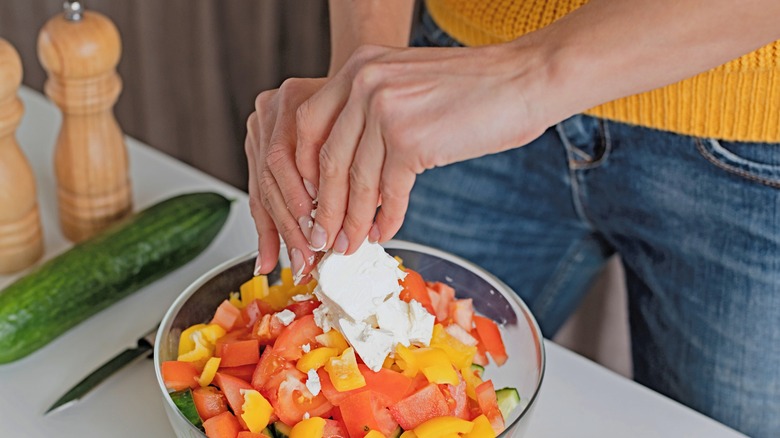
What Is The Healthiest Cheese You Can Eat? It Depends – Health Digest
Do you feel overwhelmed every time you find yourself trying to pick from all the cheeses in the supermarket? There are dozens of cheeses to choose from, and it can be hard to know which is the healthiest. From creamy cheese varieties to hard and aged cheese types, they all bring something a bit different to your plate in terms of taste, texture, and nutrients. But can cheese be good for you? If you’re a cheese lover, you may be gratified to learn that plenty of cheese types can be part of a well-balanced diet.
What makes cheese so potentially valuable as a staple ingredient? According to Samar Kullab, a registered dietitian nutritionist who goes by Chicago Dietitian on Instagram, TikTok, and YouTube, it’s their nutritional structure. “Most cheeses provide a good amount of calcium and protein,” she says.
Available data back up Kullab’s assertion. For example, information from the International Osteoporosis Foundation shows that 60 grams of feta cheese, mozzarella, and brie cheese serve up 270 milligrams, 242 milligrams, and 240 milligrams of calcium, respectively. Similarly, Healthline information indicates that 28 grams of mozzarella packs 6 grams of protein, and 28 grams of Swiss contains 8 grams of protein.
However, to get the most health-related impact from cheese, as well as choose the best cheese for you, take time to think about the results you’re after in terms of your overall health. That way, you can figure out which cheese is worth melting or nibbling — and which is better kept for special occasions (or not eaten at all).
Cheeses like ricotta and cottage can fit a low-fat, high-protein diet
Many people decide to follow low-fat, high-protein diets. That’s not a problem if you’re a cheese enthusiast because several cheese options can fit into those categories well.
For instance, Kullab recommends eating cottage cheese and ricotta cheese, both of which offer protein and are available in less fat-laden versions. “If you eat a lot of cheese, it’s a good idea to opt for varieties labeled ‘low fat’ or ‘reduced fat’ to help reduce saturated fat intake,” she explains. And you don’t have to worry about having trouble finding a low-fat or fat-free cheese since many manufacturers cater to consumers who want to reduce their fat consumption.
Where does the call for a high-protein cheese fit into the picture? By increasing your protein while lessening your fat, you can get the fuel-burning advantage of protein’s natural thermic effect. The thermic effect, as outlined by a 2019 article in the Journal of the American College of Nutrition, refers to an improvement in metabolism after eating some kinds of foods, such as those containing high levels of protein.
That means every time you eat protein-rich (and lower fat) cheese, your body will have to spend more calories digesting the protein than it would to digest similar-caloric portions of carbohydrates or fats. And the caloric expenditure of protein versus fat or carbohydrates could be as much as 30% higher, according to Healthline.
Salty cheeses like feta can be appropriate if you exercise
Are you less worried about using cheese to gain protein while staying away from too much fat? Perhaps you want to increase your salt intake instead, at least temporarily. Cheese can help you reach that goal.
Though it’s admittedly unusual to decide you want to opt for more sodium in your diet, Prevention explains that it can happen from time to time, especially if you’re exercising (and sweating) a lot. Therefore, you might be on the market to increase your sodium levels because you’re working out intensely and need to rebalance your electrolytes. In that case, a salty cheese like feta could be the best bet since it may contain salt but doesn’t contribute too calorically to your meals.
Says Kullab, “Feta cheese, while higher in sodium, is lower in fat and calories than many other cheeses. If you’re watching your sodium intake, you may want to limit it, but otherwise, it’s a nutritious choice.” For perspective, 28 grams of feta cheese promises 312 milligrams of salt, as noted by Healthline. If you’re following the U.S. Food & Drug Administration‘s daily sodium suggestion of a maximum of 2,300 milligrams, just make sure you don’t overdo it.
Goat cheese can be easier to digest with lactose intolerance
Maybe you’re concerned about limiting your intake of dairy foods due to an intolerance or allergy. Again, there’s a cheese for you. “Those who are lactose intolerant may prefer goat cheese, which is easier to digest and also lower in fat than cow’s milk cheeses,” says Gullab.
Gullab’s recommendation rings true based on input from Healthline that shows that although milk from cows contains 5.0% lactose, milk from goats contains 4.2% lactose. That’s 16% less lactose in goat’s milk, which translates into a lower-lactose cheese.
What’s the takeaway? For plenty of people trying to achieve specific wellness goals, cheese can be helpful and healthy.
Whether you’re aiming to stick to a low-fat diet, increase your consumption of protein, give your system a tiny salt boost, or add cheese to your regular menu despite having a lactose sensitivity, cheese can be a practical option. Just remember one extra detail: An abundance of cheese can add more calories, fat, or sodium to your diet than you might expect or realize.
Consequently, take Kullab’s expert guidance to heart when she notes that it’s essential to exercise thoughtful portion control. “When it comes to portion size, it depends on the type of cheese,” concludes Kullab. “A general guideline for hard cheeses is 1 ounce (28 grams), while for cottage cheese, a serving is about ½ cup, and for ricotta, it’s about ¼ cup. Another easy rule is to aim for around 100 calories per serving.”






